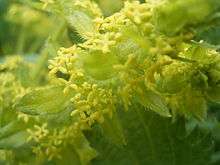Cruciata laevipes
Cruciata laevipes is a species of flowering plant in the family Rubiaceae. It is commonly known as crosswort, smooth bedstraw or Luc na croise in Gaelic.[2] The Latin epithet laevipes refers to the smooth stalk.
| crosswort smooth bedstraw | |
|---|---|
| Cruciata laevipes | |
| Scientific classification | |
| Kingdom: | Plantae |
| Clade: | Tracheophytes |
| Clade: | Angiosperms |
| Clade: | Eudicots |
| Clade: | Asterids |
| Order: | Gentianales |
| Family: | Rubiaceae |
| Genus: | Cruciata |
| Species: | C. laevipes |
| Binomial name | |
| Cruciata laevipes | |
| Synonyms[1] | |
| |
Description
This perennial sprawling plant can grow to a height of 15–70 cm (6–28 in), spreads by seeds and stolons and has, unusually amongst this group, yellow hermaphrodite flowers. The inner flowers are male and soon fall off, whilst the outer are bisexual and produce the fruit. The flowers smell of honey. Of the whorls of four leaves, only two in each group are real leaves, the other two being stipules.[3] It is associated with arbuscular mycorrhiza that penetrate the cortical cells of the roots. In the United Kingdom it flowers April to June.[4] Pollination is by bees and flies.[5]
Distribution and habitat
Cruciata laevipes is found in most of Europe as well as from northern Turkey, Iran, the Caucasus, and the western Himalayas.[1] It is also reportedly naturalized in Ontario County in New York State.[6] Cruciata laevipes is found in meadows, road verges, riverbanks, scrub and open woodland, generally on well-drained calcareous soils.[7]
Uses

Cruciata laevipes is little used in herbal medicine today, but it was once recommended as a remedy for rupture, rheumatism and dropsy.[8] Bald's Leechbook recommended crosswort as a cure for headaches.[9]
References
- Kew World Checklist of Selected Plant Families Cruciata laevipes
- ITIS Report
- Hutchinson, John (1955). British Wild Flowers. Harmondsworth : Penguin. V. 1. p. 211.
- Wildlife Trusts - Crosswort
- Plants for a Future
- Biota of North America Program, Cruciata laevipes
- The Flora of Derbyshire
- Medicinal plants
- Robert Lacey and Danny Danziger August: The Year 1000: What Life Was Like at the Turn of the First Millennium Little, Brown, 2000 ISBN 0-316-51157-9